Introduction
When working with NVIDIA’s H100 SXM servers, you may often see a configuration that includes two BFD-3 units. This raises questions, especially since the system already comes with eight CX-7 400G network cards. What are the fundamental differences and roles of BFD-3 compared to CX-7? Moreover, why does BFD have a BMC port when the server’s motherboard already includes a BMC port?
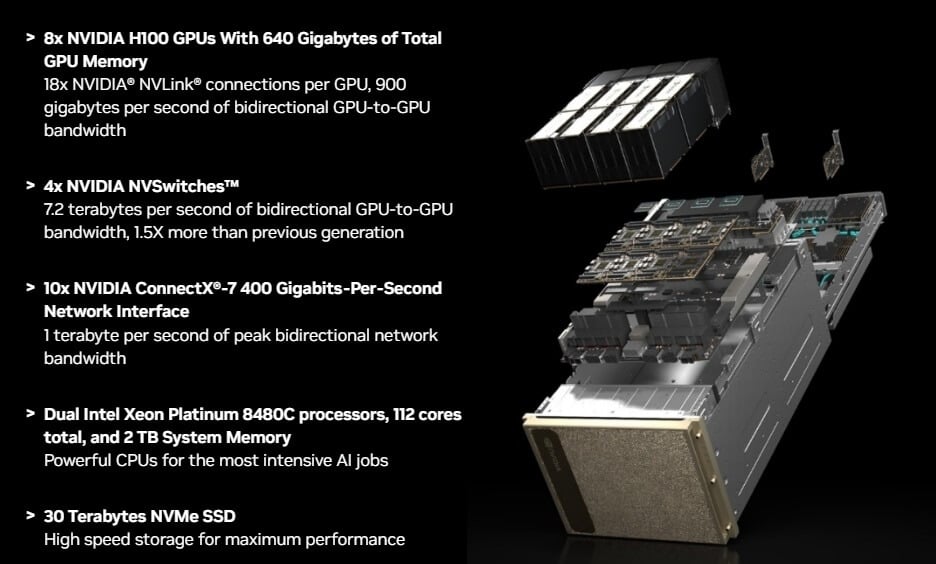
In traditional data centers, the CPU was the absolute core. However, as Moore’s Law becomes less applicable, CPU computing power growth can no longer keep up with the data explosion, leading to bottlenecks. Offloading CPU workloads to network adapters (network interface cards) has become necessary, promoting the rapid development of Smart NICs.NVIDIA defines DPU-based Smart NICs as network interface cards that offload tasks typically handled by the system CPU. Using its onboard processor, a DPU-based SmartNIC can perform a combination of encryption/decryption, firewall, TCP/IP, and HTTP processing tasks. Essentially, it assists the CPU with various tasks and has its own CPU to handle network security-related tasks independently. To address the shift in data center architecture driven by hyperscale cloud technology, NVIDIA introduced the BlueField DPU series. These new processors are designed specifically for data center infrastructure software, offloading and accelerating the massive computational workloads generated by virtualization, networking, storage, security, and other cloud-native AI services.BlueField-3 functions as an “independent node” integrated into the server’s PCIe path:
- ARM + OS: Can offload various tasks originally handled by the host OS.
- Integrated Accelerators: Improve the efficiency of processing, security, and storage of data.
- PCIe Switch Chip: Can be used in NVMe SSD expansion cabinets.
- BMC Chip: Enables independent management of the host’s original resources in a cloud environment.
The NVIDIA® BlueField®-3 DPU is the third-generation infrastructure computing platform, enabling enterprises to build software-defined, hardware-accelerated IT infrastructure from the cloud to core data centers and edge environments. With 400Gb/s Ethernet or NDR 400Gb/s InfiniBand network connectivity, the BlueField-3 DPU can offload, accelerate, and isolate software-defined networking, storage, security, and management functions, significantly enhancing data center performance, efficiency, and security. By understanding the capabilities and applications of the BlueField-3 DPU, enterprises can effectively leverage this technology to meet the demands of modern data centers and ensure robust, scalable, and secure infrastructure.
Logical Relationship Between NIC, Smart NIC, and DPU

To understand their distinctions, let’s compare the following points (personal views for reference):

Reasons for the Emergence of Smart NICs and DPUs
Era of Traditional NICs
In traditional data centers, the CPU was the absolute core. However, as Moore’s Law becomes less applicable, the growth in CPU computing power can no longer keep up with the data explosion, creating a bottleneck. Offloading the CPU’s workload onto network adapters (network interface cards) became necessary, driving the rapid development of smart NICs.
Era of Smart NICs (First Generation)
The first generation of smart NICs primarily focused on offloading tasks from the data plane. Examples include OVS Fastpath hardware offloading, RDMA network hardware offloading based on RoCEv1 and v2, hardware offloading for lossless network capabilities (PFC, ECN, ETS), NVMe-oF hardware offloading in the storage domain, and data plane offloading for secure transmission.
Era of DPU Smart NICs (Second Generation)
DPUs (Data Processing Units) emerged to address three main issues in data centers:
Between Nodes: Low efficiency of server data exchange and unreliable data transmission.
Within Nodes: Inefficient data center model execution, low I/O switch efficiency, and inflexible server architecture.
Network Systems: Insecure networks.
Differences Between NVIDIA BlueField-3 DPU and ConnectX-7 NICs
To provide a comprehensive understanding of NVIDIA’s BlueField-3 DPU, it’s essential to compare it with NVIDIA’s ConnectX-7 OSFP NIC and ConnectX-7 QSFP112 NIC. These devices serve distinct roles in data center networking, and understanding their differences and advantages can help organizations choose the right solution for their needs.
Functional Scope: DPU vs. NIC
The NVIDIA BlueField-3 DPU is a fully programmable infrastructure computing platform, integrating a powerful cluster of 16 Arm A78 cores, high-speed networking (up to 400Gb/s Ethernet or NDR InfiniBand), and hardware accelerators for tasks like networking, storage, and security. Unlike traditional NICs, the BlueField-3 DPU operates as an independent node with its own operating system, enabling it to offload complex workloads such as virtualization, NVMe-oF (NVMe over Fabrics), and zero-trust security from the host CPU. This reduces CPU overhead, enhances performance, and improves energy efficiency.
In contrast, the NVIDIA ConnectX-7 OSFP NIC and ConnectX-7 QSFP112 NIC are advanced network interface cards focused primarily on high-speed connectivity. The ConnectX-7 OSFP NIC supports single-port 400Gb/s Ethernet or NDR InfiniBand, while the ConnectX-7 QSFP112 NIC offers dual-port 200Gb/s or single-port 400Gb/s configurations. These NICs excel at low-latency, high-bandwidth data transfer but lack the programmable compute capabilities and independent OS of the BlueField-3 DPU. They are designed to handle traditional networking tasks like TCP/IP processing, RDMA (Remote Direct Memory Access), and basic offloading, but they do not support the extensive workload isolation and acceleration provided by the DPU.
Advantages of BlueField-3 DPU
The BlueField-3 DPU offers several advantages over the ConnectX-7 NICs, particularly for modern, software-defined data centers:
- Comprehensive Workload Offloading: The BlueField-3 DPU can offload and accelerate a wide range of tasks, including software-defined networking (SDN), storage (e.g., NVMe-oF), and security (e.g., firewalls, DDoS mitigation). This reduces the computational burden on the host CPU, freeing it for revenue-generating applications. For example, BlueField-3 can handle HPC/AI MPI collective operations, delivering up to a 20% speed increase and significant cost savings in large-scale supercomputing environments.
- Independent Compute Platform: With 16 Arm cores and an independent OS, the BlueField-3 DPU operates as a standalone compute node, enabling advanced use cases like micro-segmentation, multi-tenancy, and edge computing. This is particularly valuable for AI factories and cloud-native environments where scalability and security are critical.
- Enhanced Security: The DPU’s ability to isolate workloads ensures zero-trust security, protecting AI models and sensitive data from threats. For instance, when paired with F5’s BIG-IP Next for Kubernetes, BlueField-3 provides integrated firewall, DDoS mitigation, and API protection, creating a secure architecture for AI workloads.
- Energy Efficiency: By offloading tasks from the CPU, BlueField-3 reduces power consumption, making it ideal for sustainable data centers. Its high memory bandwidth and hardware accelerators further optimize performance per watt.

Model No.D3D4
Advantages of ConnectX-7 NICs
While the BlueField-3 DPU is a powerhouse for infrastructure tasks, the ConnectX-7 OSFP and QSFP112 NICs have their own strengths:
- Simplicity and Cost-Effectiveness: ConnectX-7 NICs are optimized for high-speed networking without the additional compute overhead of a DPU. They are ideal for applications requiring straightforward, low-latency connectivity, such as high-performance computing (HPC) clusters or traditional data center networking.
- Flexible Port Configurations: The ConnectX-7 QSFP112 NIC offers dual-port 200Gb/s or single-port 400Gb/s options, providing flexibility for diverse network topologies. The OSFP NIC, with its single-port 400Gb/s design, is suited for high-bandwidth, single-connection scenarios.
- Lower Complexity: For environments where advanced offloading or programmability is not required, ConnectX-7 NICs offer a simpler deployment model, reducing setup and maintenance complexity compared to the DPU’s programmable architecture.
Use Case Scenarios
Choosing between the BlueField-3 DPU and ConnectX-7 NICs depends on the specific requirements of your data center:
- BlueField-3 DPU: Best suited for modern, software-defined data centers, AI factories, and edge computing environments. It excels in scenarios requiring extensive workload offloading, such as cloud-native supercomputing, NVMe-oF storage, and zero-trust security. For example, Oracle Cloud Infrastructure (OCI) integrates BlueField-3 to optimize networking and security, enhancing cloud performance.
- ConnectX-7 NICs: Ideal for traditional networking tasks where high-speed, low-latency connectivity is the primary need. They are well-suited for HPC clusters, video streaming, or network-intensive applications that do not require advanced compute offloading.
Integration with NVIDIA Ecosystem
Both the BlueField-3 DPU and ConnectX-7 NICs leverage NVIDIA’s DOCA software development kit, which enhances programmability and accelerates innovation. However, the BlueField-3 DPU benefits from deeper integration with DOCA, enabling developers to create custom applications for networking, storage, and security. This makes the DPU a more versatile platform for next-generation data centers. Additionally, BlueField-3’s compatibility with NVIDIA’s AI systems, such as DGX SuperPOD, ensures seamless performance in massive-scale AI deployments.
Advanced Features and Performance Metrics of BlueField-3 DPU
Drawing from recent advancements and deployments highlighted in industry discussions, the BlueField-3 DPU offers unique capabilities that set it apart from the ConnectX-7 NICs, particularly in high-performance computing (HPC), AI, and cloud environments. Below, we explore additional features, performance metrics, and real-world applications to further differentiate these technologies.
Advanced Offloading for AI and HPC Workloads
The BlueField-3 DPU is designed to handle the intensive demands of AI and HPC environments by offloading critical tasks from the host CPU. According to industry insights, BlueField-3 can accelerate MPI (Message Passing Interface) collective operations, which are essential for distributed computing in AI and HPC clusters. This results in up to a 20% performance boost in large-scale supercomputing tasks, as demonstrated in NVIDIA’s DGX SuperPOD deployments. By contrast, ConnectX-7 NICs, while supporting RDMA and high-speed data transfer, lack the programmable compute capabilities to handle such complex offloading, limiting their role to connectivity rather than compute acceleration.
Storage Acceleration with NVMe-oF
The BlueField-3 DPU excels in storage acceleration, particularly with NVMe over Fabrics (NVMe-oF). It leverages hardware accelerators to reduce latency and improve throughput for distributed storage systems. For example, BlueField-3 can process NVMe-oF workloads with minimal CPU involvement, achieving up to 2x higher IOPS (Input/Output Operations Per Second) compared to software-based solutions. The ConnectX-7 NICs, while capable of supporting NVMe-oF through RDMA protocols like RoCE (RDMA over Converged Ethernet), rely on host CPU processing for most storage tasks, making them less efficient for complex storage workloads.
Security and Isolation for Cloud-Native Environments
In cloud-native environments, the BlueField-3 DPU provides robust security features through workload isolation and zero-trust architectures. It can run virtualized security functions, such as firewalls and intrusion detection systems, directly on the DPU, reducing the attack surface of the host system. For instance, integration with F5’s BIG-IP Next for Kubernetes enables BlueField-3 to deliver advanced API protection and DDoS mitigation, critical for securing AI workloads in Kubernetes clusters. The ConnectX-7 NICs, while supporting basic security offloads like IPsec, lack the independent compute platform needed for such comprehensive security functions.
Real-World Deployments and Ecosystem Synergies
The BlueField-3 DPU has been adopted in cutting-edge deployments, such as Oracle Cloud Infrastructure (OCI) and NVIDIA’s own AI factories. In OCI, BlueField-3 optimizes network virtualization and storage acceleration, improving cloud performance by up to 30% in data-intensive workloads. Additionally, its integration with NVIDIA’s DOCA SDK allows developers to build custom applications tailored to specific use cases, such as real-time analytics or edge AI. The ConnectX-7 NICs, while integral to NVIDIA’s networking ecosystem, are primarily used in scenarios requiring high-speed interconnects, such as in HPC clusters or data center backbones, without the same level of programmability or ecosystem integration.
Performance Metrics Comparison
To quantify the differences, consider the following metrics:
- BlueField-3 DPU: Up to 400Gb/s throughput, 16 Arm A78 cores, 32GB onboard DDR4 memory, and hardware accelerators for encryption, compression, and storage. It can reduce CPU utilization by up to 50% in virtualized environments by offloading tasks like OVS (Open vSwitch) and NVMe-oF.
- ConnectX-7 OSFP NIC: Single-port 400Gb/s Ethernet or NDR InfiniBand, optimized for low-latency RDMA (sub-microsecond latency), but no onboard compute cores or memory for independent processing.
- ConnectX-7 QSFP112 NIC: Dual-port 200Gb/s or single-port 400Gb/s, similar RDMA performance to OSFP, but designed for flexible port configurations rather than compute-intensive tasks.
These metrics highlight the BlueField-3 DPU’s ability to handle both networking and compute tasks, making it a more versatile solution for modern data centers compared to the ConnectX-7 NICs, which are optimized for connectivity alone.
Choosing the Right Solution
For organizations building AI factories, cloud-native data centers, or edge computing solutions, the BlueField-3 DPU is the superior choice due to its programmability, workload offloading, and security features. For example, in AI training clusters, BlueField-3 can reduce training times by offloading communication tasks, as seen in NVIDIA’s DGX H100 systems. Conversely, the ConnectX-7 NICs are better suited for traditional networking environments, such as enterprise data centers or HPC clusters, where high-speed, low-latency connectivity is the primary requirement without the need for advanced compute offloading.
Simplified Explanation: Why DPUs Are Superior to Smart NICs
NVIDIA defines DPU-based smart NICs as network interface cards that offload tasks usually handled by the system CPU. Using its onboard processor, a DPU-based SmartNIC can perform a combination of encryption/decryption, firewall, TCP/IP, and HTTP processing tasks. Essentially, it assists the CPU with various tasks and has its own CPU to handle network security-related tasks independently.
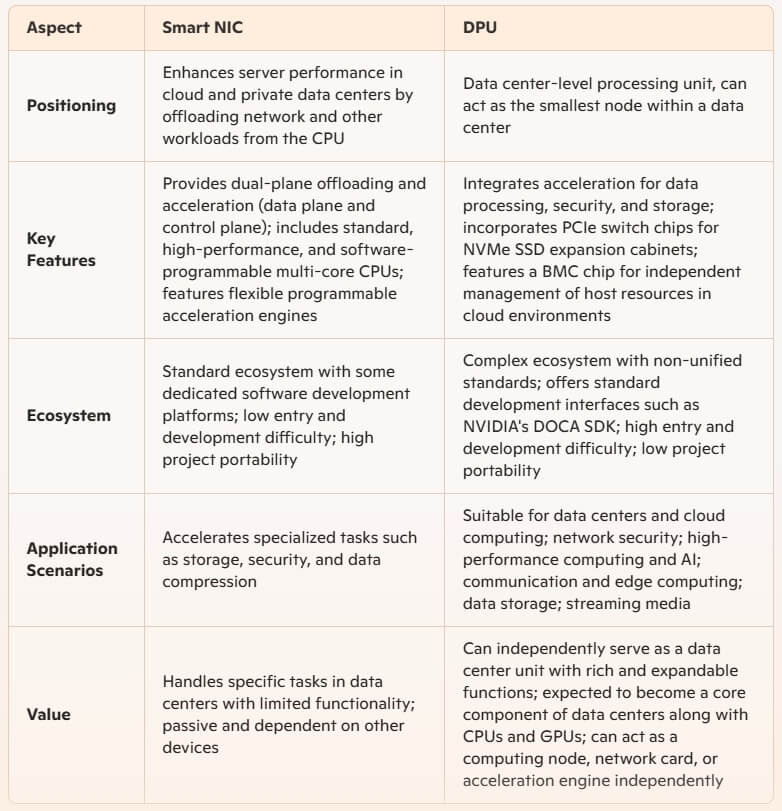
Overview of NVIDIA BlueField-3 DPU
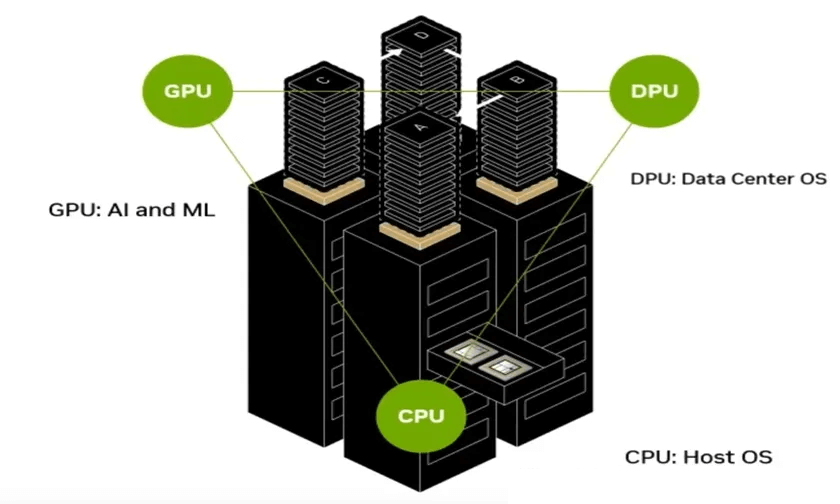
To address the shift in data center architecture driven by hyperscale cloud technology, NVIDIA introduced the BlueField DPU series. These new processors are designed specifically for data center infrastructure software, offloading and accelerating the massive computational workloads generated by virtualization, networking, storage, security, and other cloud-native AI services.
System Layout of NVIDIA BlueField-3 DPU
BlueField-3 functions as an “independent node” integrated into the server’s PCIe path:
- ARM + OS: Can offload various tasks originally handled by the host OS.
- Integrated Accelerators: Improve efficiency in data processing, security, and storage.
- PCIe Switch Chip: Can be used in NVMe SSD expansion cabinets.
- BMC Chip: Allows independent management of original host resources in a cloud environment.
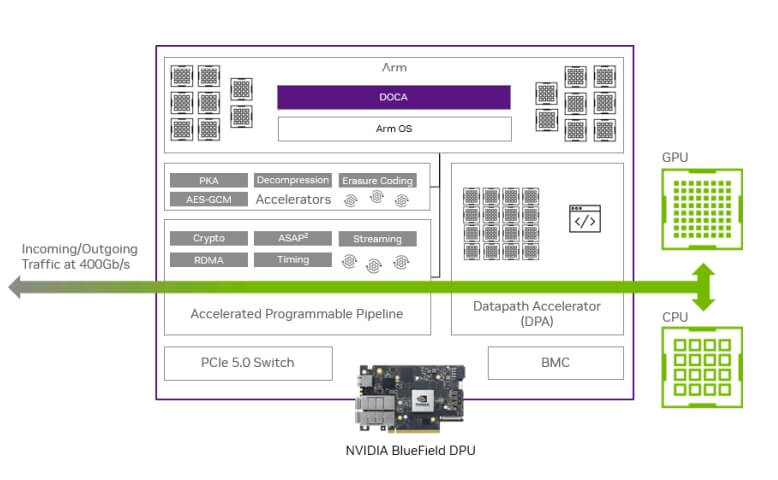
Recommended Use Cases for BlueField-3
NVIDIA® BlueField®-3 DPU is the third-generation infrastructure computing platform, enabling enterprises to build software-defined, hardware-accelerated IT infrastructure from the cloud to core data centers and edge environments. With 400Gb/s Ethernet or NDR 400Gb/s InfiniBand network connectivity, the BlueField-3 DPU can offload, accelerate, and isolate software-defined networking, storage, security, and management functions, significantly enhancing data center performance, efficiency, and security.
Example Application of BlueField-3 in VMware Private Cloud
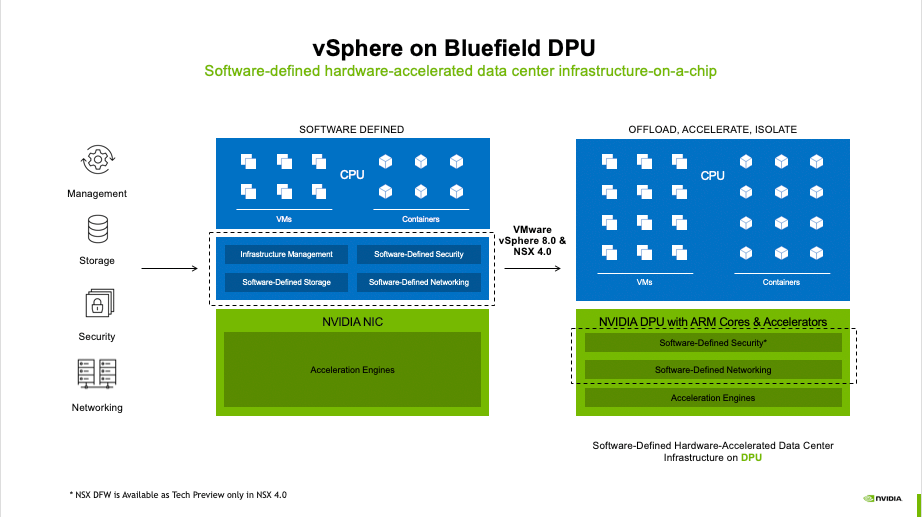
NVIDIA DPU Roadmap
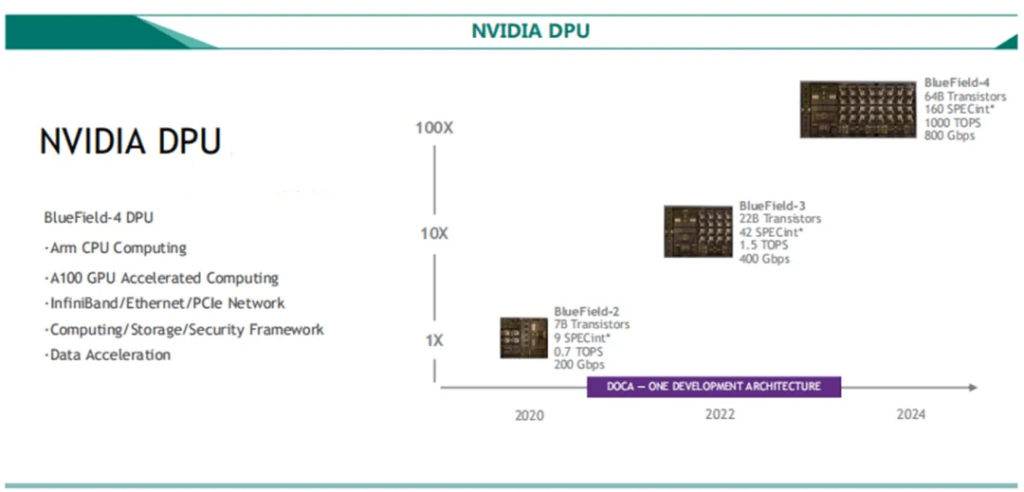
By understanding the capabilities and applications of the BlueField-3 DPU, enterprises can effectively leverage this technology to meet the demands of modern data centers and ensure robust, scalable, and secure infrastructure.
Related Products:
-
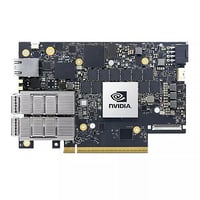 NVIDIA B3220 BlueField-3 DPU, P-Series FHHL, 200GbE (Default Mode)/NDR200 lB, Dual-port QSFP112, PCle Gen5.0x16 with x 16 PCle Extension Option ,16 Arm Cores, 32GB Onboard DDR, Integrated BMC, Crypto Disabled, Tall Bracket
$4490.00
NVIDIA B3220 BlueField-3 DPU, P-Series FHHL, 200GbE (Default Mode)/NDR200 lB, Dual-port QSFP112, PCle Gen5.0x16 with x 16 PCle Extension Option ,16 Arm Cores, 32GB Onboard DDR, Integrated BMC, Crypto Disabled, Tall Bracket
$4490.00
-
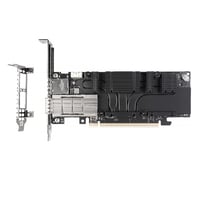 NVIDIA B3140H BlueField-3 8 Arm-Cores SuperNIC, E-series HHHL, 400GbE (Default Mode)/NDR IB, Single-port QSFP112, PCle Gen5.0 x16, 16GB Onboard DDR, Integrated BMC, Crypto Disabled
$4390.00
NVIDIA B3140H BlueField-3 8 Arm-Cores SuperNIC, E-series HHHL, 400GbE (Default Mode)/NDR IB, Single-port QSFP112, PCle Gen5.0 x16, 16GB Onboard DDR, Integrated BMC, Crypto Disabled
$4390.00
-
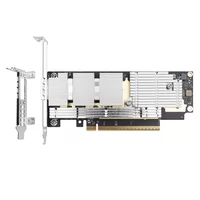 NVIDIA Mellanox MCX75310AAS-NEAT ConnectX-7 InfiniBand/VPI Adapter Card, NDR/400G, Single-port OSFP, PCIe 5.0x 16, Tall Bracket
$2200.00
NVIDIA Mellanox MCX75310AAS-NEAT ConnectX-7 InfiniBand/VPI Adapter Card, NDR/400G, Single-port OSFP, PCIe 5.0x 16, Tall Bracket
$2200.00
-
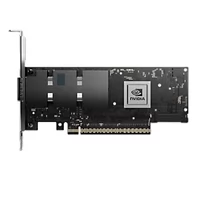 NVIDIA Mellanox MCX75510AAS-NEAT ConnectX-7 InfiniBand/VPI Adapter Card, NDR/400G, Single-port OSFP, PCIe 5.0x 16, Tall Bracket
$1650.00
NVIDIA Mellanox MCX75510AAS-NEAT ConnectX-7 InfiniBand/VPI Adapter Card, NDR/400G, Single-port OSFP, PCIe 5.0x 16, Tall Bracket
$1650.00
